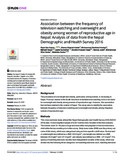Association between the frequency of television watching and overweight and obesity among women of reproductive age in Nepal: Analysis of data from the Nepal Demographic and Health Survey 2016
Date
2020-02-10Publisher
PLOS ONEAuthor
Gupta, Rajat DasHaider, Shams Shabab
Hashan, Mohammad Rashidul
Hasan, Mehedi
Sutradhar, Ipsita
Sajal, Ibrahim Hossain
Joshi, Hemraj
Haider, Mohammad Rifat
Sarker, Malabika
Metadata
Show full item recordCitation
Gupta, R. D., Haider, S. S., Hashan, M. R., Hasan, M., Sutradhar, I., Sajal, I. H., . . . Sarker, M. (2020). Association between the frequency of television watching and overweight and obesity among women of reproductive age in Nepal: Analysis of data from the Nepal demographic and health survey 2016. PLoS ONE, 15(2) doi:10.1371/journal.pone.0228862Abstract
Background
The prevalence of overweight and obesity, particularly among women, is increasing in
Nepal. Previous studies in the South Asia have found television watching to be a risk factor
for overweight and obesity among women of reproductive age. However, this association
had not been studied in the context of Nepal. This study aims to identify the association
between frequency of television watching and overweight and obesity among Nepalese
women of reproductive age.
Methods
This cross-sectional study utilized the Nepal Demographic and Health Survey 2016 (NDHS
2016) data. A total weighted sample of 6,031 women were included in the final analyses.
The women were 15–49 years of age and were either not pregnant or had not delivered a
child within the two months prior to the survey. Body mass index (BMI) was the primary outcome of this study, which was categorized using an Asia-specific cutoff value. Normal and/
or underweight was defined as a BMI <23.0 kg/m2
, overweight was defined as a BMI
between 23.0 kg/m2 and <27.5 kg/m2
, and obesity was defined as a BMI �27.5 kg/m2
. Frequency of watching television was the main independent variable of this study, which was
divided into the following three categories: not watching television at all, watching television
PLOS ONE | https://doi.org/10.1371/journal.pone.0228862 February 10, 2020 1 / 13
a1111111111
a1111111111
a1111111111
a1111111111
a1111111111
OPEN ACCESS
Citation: Das Gupta R, Haider SS, Hashan MR,
Hasan M, Sutradhar I, Sajal IH, et al. (2020)
Association between the frequency of television
watching and overweight and obesity among
women of reproductive age in Nepal: Analysis of
data from the Nepal Demographic and Health
Survey 2016. PLoS ONE 15(2): e0228862. https://
doi.org/10.1371/journal.pone.0228862
Editor: Cindy Gray, University of Glasgow, UNITED
KINGDOM
Received: July 20, 2019
Accepted: January 25, 2020
Published: February 10, 2020
Peer Review History: PLOS recognizes the
benefits of transparency in the peer review
process; therefore, we enable the publication of
all of the content of peer review and author
responses alongside final, published articles. The
editorial history of this article is available here:
https://doi.org/10.1371/journal.pone.0228862
Copyright: © 2020 Das Gupta et al. This is an open
access article distributed under the terms of the
Creative Commons Attribution License, which
permits unrestricted use, distribution, and
reproduction in any medium, provided the original
author and source are credited.
Data Availability Statement: The dataset of NDHS
2016 is available at the Demographic and Health
less than once a week, and watching television at least once a week. Multilevel ordered
logistic regression was conducted to find the factors associated with overweight and obesity.
A p-value <0.05 was considered significant in the final model.
Results
Around 35% of the participants were overweight or obese (overweight: 23.7% and obese:
11.6%). A majority of the study participants was aged between 15 and 24 years (36.5%),
and resided in an urban area (63.2%), Province No. 3 (22.3%), and the Terai ecological
region (49.5%). Around one-third (34.0%) of the participants received no formal education
while an almost similar proportion (35.5%) completed secondary education. Approximately
half of the study participants (50.6%) reported watching television at least once a week,
whereas more than a quarter (28.7%) of them did not watch television at all. Women who
watched television at least once a day had a higher prevalence of overweight and obesity
than the other groups (p-value <0.0001). Women who watched television at least once a
week were 1.3 times more likely to be overweight or obese in comparison to women who
never watched television (Adjusted Odds Ratio (AOR): 1.3, 95% CI: 1.0–1.7; p-value
<0.05). In the urban areas, women who watched television at least once a week were 40%
more likely to be overweight or obese than those who did not watch television at all (AOR:
1.4, 95% CI: 1.1–1.7; p-value <0.01). No significant association between overweight and
obesity and the frequency of viewing television was observed in the rural area.
Conclusions
Watching television at least once a week is associated with overweight and obesity in
women of reproductive age living in the urban areas of Nepal. Public health promotion programs should raise awareness among women regarding harmful health consequences of
sedentary lifestyle due to television watching.

